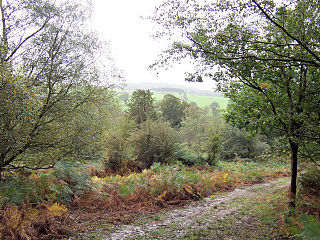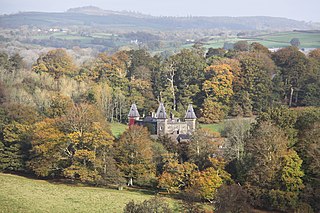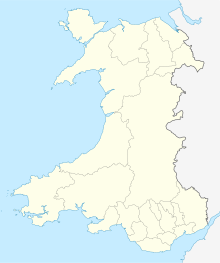
Beaumaris Castle, in Beaumaris, Anglesey, Wales, was built as part of Edward I's campaign to conquer north Wales after 1282. Plans were probably first made to construct the castle in 1284, but this was delayed due to lack of funds and work only began in 1295 following the Madog ap Llywelyn uprising. A substantial workforce was employed in the initial years under the direction of James of St George. Edward's invasion of Scotland soon diverted funding from the project, however, and work stopped, only recommencing after an invasion scare in 1306. When work finally ceased around 1330 a total of £15,000 had been spent, a huge sum for the period, but the castle remained incomplete.

Attingham Park is an English country house and estate in Shropshire. Located near the village of Atcham, on the B4380 Shrewsbury to Wellington road. It is owned by the National Trust. It is a Grade I listed building.
Sir Richard Bulkeley of Beaumaris, Anglesey and Lewisham, was a Welsh politician and courtier of Elizabeth Tudor, who sat in the House of Commons of England in 1563 and from 1604 to 1614.

Viscount Bulkeley, of Cashel in the County of Tipperary, was a title in the Peerage of Ireland. It was created on 19 January 1644 for Thomas Bulkeley, the son of Sir Richard Bulkeley of Beaumaris and a supporter of King Charles I of England. The title descended from father to son until the death of his great-great-grandson, the 5th Viscount, in 1738. The late Viscount was childless and was succeeded by his younger brother, the 6th Viscount. The latter was succeeded by his son, the 7th Viscount. The 7th Viscount was also created Baron Bulkeley, of Beaumaris, in the County of Anglesey, in the Peerage of Great Britain on 14 May 1784, which entitled him to a seat in the House of Lords. In 1802 he assumed by Royal licence the additional surname of Warren, which was that of his father-in-law, Sir George Warren. On his death in 1822 both titles became extinct. Sir Richard Williams, of Penrhyn, succeeded to the Bulkeley estates and assumed by Royal licence the additional surname of Bulkeley.
Thomas Bulkeley, 1st Viscount Bulkeley (1585–1659) was a landowner from North Wales who supported the Royalist cause during the English Civil War.
The Williams, later Williams-Bulkeley Baronetcy, of Penrhyn in the County of Caernarvon, is a title in the Baronetage of England. It was created on 17 June 1661 for Griffith Williams. He had already been granted a baronetcy by Oliver Cromwell in 1658. The second Baronet represented both Caernarvonshire and Caernarvon in the House of Commons. The eighth Baronet sat as Member of Parliament for Beaumaris while the ninth Baronet represented Caernarvonshire and Beaumaris. The tenth Baronet was Member of Parliament for Beaumaris, Anglesey and Flint Boroughs and served as Lord Lieutenant of Caernarvonshire. In 1826 he assumed by Royal licence the additional surname of Bulkeley on succeeding to the estates of Thomas James Bulkeley, 7th Viscount Bulkeley. The twelfth and thirteenth Baronets were both Lord Lieutenant of Anglesey while the latter was also Lord Lieutenant of Gwynedd. The family seat is Baron Hill, Anglesey. Arms of Williams of Penrhyn: Gules, a chevron ermine between three Saxon's heads in profile couped proper.

Eridge Park is a village and historic park located north of the parish of Rotherfield, to the north-east of Crowborough in East Sussex, England. The adjoining home of the same name is the seat of the Marquess of Abergavenny. The area is a biological Site of Special Scientific Interest.

Dinefwr Park National Nature Reserve is an 800 acres (320 ha) estate about a mile from the centre of Llandeilo in Carmarthenshire owned by the National Trust, with a mansion in the centre. The highest point is occupied by the ruined Dinefwr Castle, ancient castle of the Deheubarth kingdom. It is a grade I Historic Park and a Site of Special Scientific Interest.
Robert Bulkeley, 2nd Viscount Bulkeley of Cashel was a British peer and politician.

Sir Richard Bulkeley Williams-Bulkeley, 10th Baronet was an English Whig and Liberal Party politician who sat in the House of Commons variously between 1831 and 1868.
Richard Bulkeley was a Welsh politician who sat in the House of Commons between 1626 and 1629.

Bodorgan Hall is a country house and estate located in the hamlet of Bodorgan, Anglesey, Wales, situated near the Irish Sea in the southwestern part of the island. The hall is the seat of the Meyricks, and is the largest estate on Anglesey. The hall is the home of Sir George Meyrick and his wife, Lady Jean Tapps Gervis Meyrick, who is the niece of the Duke of Buccleuch.

St Mary and St Nicholas Church, Beaumaris, an Anglican church, is a fourteenth century Grade I listed building in Beaumaris, Anglesey, Wales.
Richard Bulkeley, 3rd Viscount Bulkeley was a Welsh politician and peer.
Richard Bulkeley, 4th Viscount Bulkeley, of Baron Hill, Anglesey, was a Welsh Tory politician who sat in the House of Commons between 1704 and 1724. He was extremely hot-tempered and was involved in several personal and family disputes with local Whig leaders.
Llanfaes Friary was a Franciscan friary in the now vanished medieval town of Llanfaes, close to what is now Beaumaris, in south east Anglesey, Wales. It was founded around 1237 in memory of Joan, wife of Llywelyn ab Iorwerth. The Friary survived the depopulation of the town, but was dissolved in 1538 and most of the buildings dismantled soon afterwards. The land became an estate on which, in 1623, Rowland Whyte built a house which he called Friars. It became one of the many properties of the Bulkeley family, and was substantially rebuilt in 1866. By the 20th century the house and grounds were owned by James Hartley Burton. In 1939 they were requisitioned for wartime use, adapting and repairing flying boats, by Saunders-Roe, who continued after the war with a wide variety of light engineering activities. The industrial uses finally came to an end in the late 1990s. An archaeological dig on the site in 1991 identified substantial buried remains of the friary church and other monastic buildings. The site is a Scheduled monument.
Richard Bulkeley, 5th Viscount Bulkeley of Baron Hill, Anglesey was a Welsh landowner and Tory politician who sat in the House of Commons from 1730 to 1738.
James Bulkeley, 6th Viscount Bulkeley of Baron Hill, Anglesey, was a Welsh landowner and Tory politician who sat in the House of Commons from 1739 to 1752.
Sir Hugh Williams, 8th Baronet, was a British soldier and politician who sat in the House of Commons between 1768 and 1794.










